Tropical Hibiscus: Care and Growing Guide (With Pictures)
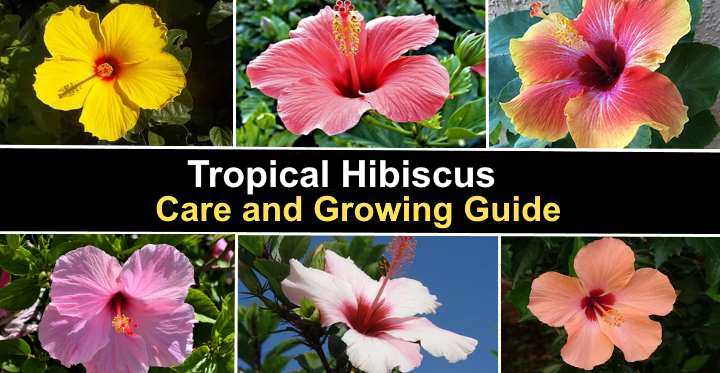
Tropical hibiscus (Hibiscus rosa-sinensis) is a group of beautiful evergreen flowering shrubs that produce huge, colorful flowers. Also called Chinese hibiscus, Hawaiian hibiscus, or shoeblack plant, the flowers on these tropical plants can be up to 10” (25 cm) in diameter. Tropical hibiscus flowers can be shades of pink, white, purple, yellow, orange, and red. Very often, the blooms on tropical hibiscus are funnel-shaped with a dark-colored center.
This article is a complete guide to growing tropical hibiscus shrubs or small trees in your backyard. At the end of the article, you will learn about some of the best tropical hibiscus cultivars to grow in the ground or pots.
How to Care for Tropical Hibiscus
To care for Hibiscus rosa-sinensis, grow the tropical hibiscus in full sun and well-draining soil that is always moist. You should water Hawaiian hibiscus plants regularly during summer, especially in hot weather. Fertilize every two weeks in spring and summer with a high-nitrogen fertilizer. Prune in late fall to encourage healthy foliage and blooming.
Tropical Hibiscus Facts
Most tropical hibiscus plants are cultivars of the species Hibiscus rosa-sinensis in the family Malvaceae. The botanical name for tropical hibiscus literally means “rose of China.” Because there are species of hibiscus native to Hawaii, they are also called Hawaiian hibiscus plants.
Hibiscus rosa-sinensis only grows in tropical or subtropical climates. The large evergreen shrubs grow between 8 and 16 ft. (2.5 – 5 m) tall and up to 10 ft. (3 m) wide. Tropical hibiscus only grows outdoors in USDA zones 9 through 12. However, some species such as Hibiscus grandiflorus (swamp rose mallow), Hibiscus arnottianus (Hawaiian hibiscus), and Hibiscus mutabilis (Confederate rose) will grow in gardens in zones 7 through 9.
The dense, leafy foliage of hibiscus plants and their exotic flowers make them ideal for flowering hedges.
If you live in temperate climates with freezing winters, you can grow tropical hibiscus in containers and overwinter them indoors.
Tropical Hibiscus Flowers

Tropical hibiscus flowers come in a wide variety of colors and can be single or double blooms
Tropical hibiscus flowers look like enormous colorful funnels with a protruding stamen. The dramatic blooms are made up of large papery petals that have a ruffled appearance. Colors of tropical hibiscus can be hues of red, crimson, pink, white, orange, yellow and purple. Some of the most spectacular showy hibiscus flowers are multicolored.
Exotic tropical hibiscus blossoms only last a day or two. However, the flowering shrubs with their glossy green foliage continuously bloom. This means that hibiscus flowers throughout the summer and even longer, filling your front or backyard with spectacular trumpet-shaped flowers.
Tropical Hibiscus (Hibiscus rosa-sinensis) Tree
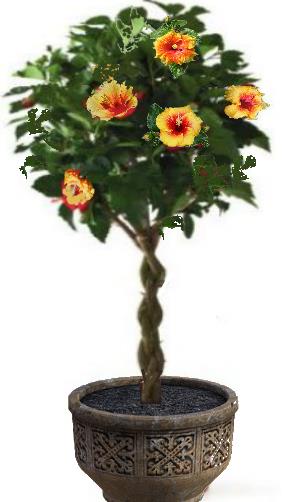
Braided hibiscus tree
The tropical tree, Hibiscus rosa-sinensis, is a large shrub, often sold in containers. Braided hibiscus trees are beautiful ornamental plants with thin twisting and intertwining trunks. Usually, braided tropical hibiscus trees grow between 5 and 6 ft. (1.5 – 1.8 m) tall. The flowering trees produce large funnel flowers, sometimes all year-round.
Tropical Hibiscus (Hibiscus rosa-sinensis) Care Guide
Let’s look in more detail at how to grow tropical hibiscus shrubs and small trees in your front or backyard.
Where to Plant Tropical Hibiscus Shrubs and Trees
Grow hibiscus shrubs in the ground in the sunniest part of your garden. Tropical hibiscus thrives on plenty of sunlight and needs at least six hours a day of sunlight to grow well. Plenty of sunshine keeps hibiscus shrubs flowering for most of the year. You can also grow hibiscus in partial shade; however, it won’t bloom as much.
In scorching climates, hibiscus plants benefit from some shade. The high temperatures and intense sunlight can cause some foliage burn. If you get bright, hot summers, it’s best to plant hibiscus in partial sun.
The Best Soil for Hawaiian Hibiscus (Hibiscus rosa-sinensis)
Tropical hibiscus growing in the ground or containers need porous soil that holds moisture but has excellent drainage. The best type of hibiscus soil has a fair amount of organic matter to provide nutrients and stay moist. A layer of mulch over the root zone can prevent moisture loss and improve soil fertility.
The best garden soil for tropical hibiscus should be slightly acidic. Aim for a pH level between 6.5 and 6.8. You can amend the soil with lime to increase the pH or sulfur to lower the pH levels.
However, the most critical care factor for hibiscus plants is that the soil remains moist but is never waterlogged.
How to Water Tropical Hibiscus Plants
Water tropical hibiscus daily during warm weather to encourage blooming. Generally, tropical hibiscus plants are thirsty and need continual moisture.
However, watering frequency depends on weather conditions. In hot weather, you might have to water hibiscus twice a day.
Signs of overwatering Chinese hibiscus are yellow leaves near the bottom or middle of the plant. If the ground is parched, the lush, glossy green leaves may turn yellow and start dropping.
Top care tip for watering hibiscus shrubs and trees: Always avoid letting the hibiscus roots sit in soggy soil. This is vital for growing hibiscus in the ground or containers.
Temperature Requirements for Growing Tropical Hibiscus (Hibiscus rosa-sinensis)
Tropical hibiscus cultivars need temperatures of at least 50°F (10°C). Best hibiscus growth and blooming occur when the plant grows in temperatures between 55°F and 85°F (12°C – 30°C). Even though hibiscus plants are tropical, their growth can suffer if temperatures exceed 100°F (37°C).
Hibiscus rosa-sinensis and other tropical hibiscus cultivars can’t tolerate the cold. Even a short cold snap below 35°F (1.5°C) can damage the plant. It’s vital to ensure that hibiscus growing in the ground or pots never gets any frost damage.
If you get cold winters but want tropical-looking flowers in your backyards, choose from the many rose of Sharon cultivars (Hibiscus syriacus). These cold-hardy hibiscus varieties can survive in USDA zones 4 through 9.
How Much Humidity Tropical Hibiscus Needs
Warm, humid conditions are perfect for growing a Chinese hibiscus in the garden. If the weather is exceptionally hot and dry, you will need to water the plant more frequently to keep it hydrated. Also, ensure that there is plenty of air circulation around the foliage to prevent conditions such as powdery mildew.
How to Fertilize Tropical Hibiscus
Exotic hibiscus plants growing in tropical climates benefit from regular fertilization. Apply a diluted potassium-rich fertilizer once a week during the summertime to encourage plenty of blooms. During warm winters, you should hold off fertilizing hibiscus and just water occasionally to keep the ground moist.
To choose the right type of fertilizer, choose one suitable for flowering tropical plants. For example, a fertilizer with an NPK rating of 9-3-13 or 10-4-12 is perfect. The high potassium and nitrogen and low phosphorus help the plant to bloom well.
You can also amend the soil with organic compost in spring to provide plenty of nutrients for healthy growth.
Tropical Hibiscus (Hibiscus rosa-sinensis) Pruning
Prune tropical hibiscus plants growing in the ground or a container in the fall. Pruning dead branches stimulates new growth in spring and keeps your plant blooming with plenty of exotic flowers. Pruning tropical hibiscus also thins out foliage to allow more light and air to get to the plant.
Pruning is an important way to care for tropical hibiscus plants. Because the heat-loving plant doesn’t die back, it’s necessary to tidy the plant’s growth once a year. The stunning tropical flowers grow on new growth, so you will get even more hibiscus flowers by regular pruning.
Propagating Tropical Hibiscus
The best way to propagate tropical hibiscus is by stem cuttings in spring or early summer. Cut about 4” to 6” (10 – 15 cm) of new growth just below a node. Remove any foliage, apart from the top set of leaves. You can dip the cut end of the stem in rooting hormone.
Plant the cutting in a potting mix containing equal parts of potting soil and perlite. Mist the soil to moisten it, cover with a plastic bag to increase humidity. It’s also vital to ensure the bag doesn’t touch the leaves. Place in a warm, bright location and mist the soil regularly to keep it moist.
Roots should appear after about eight weeks when you can transfer the tropical hibiscus to a larger pot. After a full season, you can plant the hibiscus in your garden.
Top tip for growing tropical hibiscus: Tropical hibiscus is tricky to propagate, so increase your chances of success by taking a few stem cuttings to root.
Transplanting Tropical Hibiscus
You may need to transplant a tropical hibiscus to move it to a sunnier or shadier area of your garden. The best time to transplant Hibiscus rosa-sinensis is in spring. Before moving the sun-loving plant to a new location, it’s vital to prepare the hole beforehand. Remember to plant the shrub at the same height as it was growing previously.
Pests Affecting Tropical Hibiscus Growth
Hibiscus rosa-sinensis and other tropical hibiscus varieties can be susceptible to some garden pests. Aphids, mealybugs, spider mites, and scale insects can affect the plant’s growth. Many of these bugs pierce the soft foliage and suck the plant’s sap. A large pest infestation can weaken hibiscus growth.
Get rid of pests from hibiscus by using a neem oil spray. Mix 2 tsp. neem oil and 1 tsp. liquid dish soap for every quart (1 l) of water. Mix the natural pesticide in a spray bottle and liberally spray the solution over the foliage, making sure to coat the leaves’ undersides. Repeat the treatment weekly for best results.
Related reading: How to spot the signs of common plant pests.
Diseases Affecting Tropical Hibiscus Growth
Diseases generally don’t affect tropical hibiscus plants. However, tropical hibiscus roots sitting in saturated ground can start to decay and develop root rot. You may notice that buds don’t open or leaves turn yellow, wilt, and drop if root rot has set in. To prevent rotting roots, never overwater the exotic plant.
Powdery mildew can also affect tropical hibiscus plants. You can treat powdery mildew by mixing 6 fl. oz. (180 ml) of milk with 14 fl. oz. (400 ml) of water and spraying the leaves. Powdery mildew is a white, dusty-looking substance that can cause the leaves and foliage to look diseased. You can avoid this unsightly mold by ensuring there’s plenty of air circulation around the plant and the shrub gets enough sunlight.
Growing Tropical Hibiscus in Pots
Many tropical hibiscus cultivars grow well in containers. Potted hibiscus plants are ideal backyard plants for warm summers in temperate climates or year-long container plants in the tropics. Grow the hibiscus shrub in loose, well-draining soil. Ensure the heat-loving plant gets at least six hours of sunshine daily and only water the soil when the top layer is dry.
FAQs About Tropical Hibiscus (Hibiscus rosa-sinensis) Care
How to winterize tropical hibiscus
Tropical hibiscus growing in zones 9 through 12 don’t die back in winter. However, if you grow flowering hibiscus in containers, you will need to bring them indoors when the temperature drops below 50°F (10°C). Put the hibiscus pot in the sunniest location in your house and water when the top layer of soil dries.
Should you cut back tropical hibiscus?
Tropical hibiscus plants keep growing all year long in USDA zones 9 through 12. So, you don’t need to cut back the tropical plants to the ground. You can cut back tropical hibiscus by about one-third in spring to encourage new growth.
How can you tell if your hibiscus is hardy or tropical?
Tropical hibiscus is an evergreen shrub that flowers for most of the year, whereas hardy hibiscus cultivars are deciduous. Also, tropical hibiscus plants tend to have glossier leaves and smaller flowers. However, both tropical and hardy hibiscus cultivars have varieties with large blooms.
Do you deadhead tropical hibiscus?
It’s not necessary to deadhead tropical hibiscus plants. Usually, tropical hibiscus flowers are self-cleaning—meaning they drop off on their own. Deadheading refers to snipping off flowers after they have finished blooming. Hibiscus plants only bloom for between one and three days.
Types of Tropical Hibiscus (Hibiscus rosa-sinensis)
Here are a few examples of tropical Hibiscus rosa-sinensis, including some Hawaiian hibiscus cultivars.
Tropical hibiscus ‘Brilliant’ (Hibiscus rosa-sinensis ‘Brilliant’)

The ‘Brilliant’ tropical hibiscus has bright red ruffled flowers with large red and yellow stamen emerging from its funnel-shaped blooms. The hibiscus ‘Brilliant’ has glossy, oval leaves and dense foliage. Hibiscus rosa-sinensis grows between 8 and 10 ft. (2.4 – 3 m) tall and up to 6 ft. (1.8 m) wide.
Brackenridge’s rosemallow (Hibiscus brackenridgei)
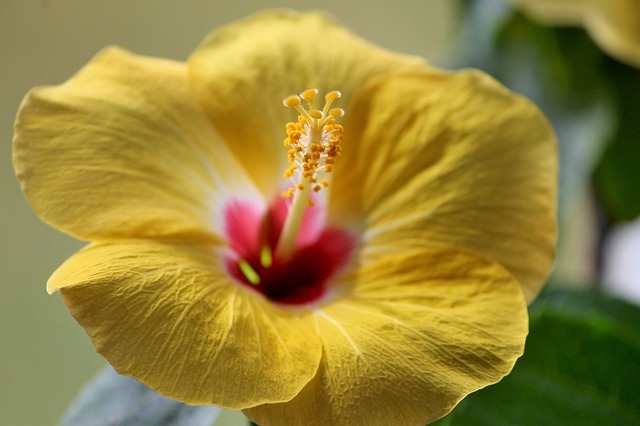
This native Hawaiian hibiscus is a bold flowering shrub with large, yellow oval disc-shaped ruffled blooms, up to 6” (15 cm) across. The stunning flowers have a yellow stamen protruding from the funnel center, giving the shrub a tropical feel of the Hawaiian islands. Also called Ma’o Hau Hele, this tropical hibiscus grows between 3 and 15 ft. (1 – 4.5 m) tall.
Topical hibiscus rosa-sinensis ‘Erin Rachel’
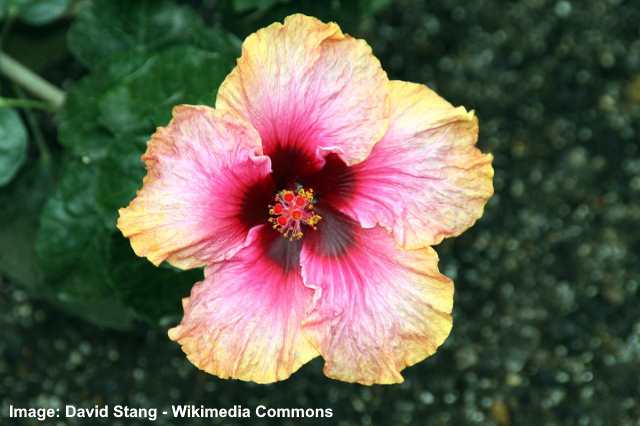
The tropical hibiscus ‘Erin Rachel’ has trumpet-shaped flowers with crinkled petals that are gentle pastel tones of pink and orange. In cooler climates, you can grow hibiscus ‘Erin Rachel’ as an annual or in containers. ‘Erin Rachel’ hibiscus grows between 6 and 8 ft. (1.8 – 2.4 m) and is 10 ft. (3 m) wide)
Hibiscus rosa-sinensis ‘Madonna’

The tropical hibiscus ‘Madonna’ has large saucer-like white flowers with a red to dark burgundy center. The long-blooming shrub thrives in USDA zones 9 and 10. Expect the tropical shrub to grow between 6 and 8 ft (1.8 – 2.4 m).
Hibiscus rosa-sinensis ‘Harry Boris’

The hibiscus ‘Harry Boris has delightful showy blooms that are a soft orange to chocolate color and a dark red center. The attractive five-petaled flower also has whitish veins, and the petal margins are wavy. As with most tropical hibiscus plants, grow them in full sun and water well so that the shrub flowers for most of the year. ‘Harry Boris’ hibiscus grows around 5ft. tall (1.5 m).
Hibiscus rosa-sinensis ‘Waimea Pink’
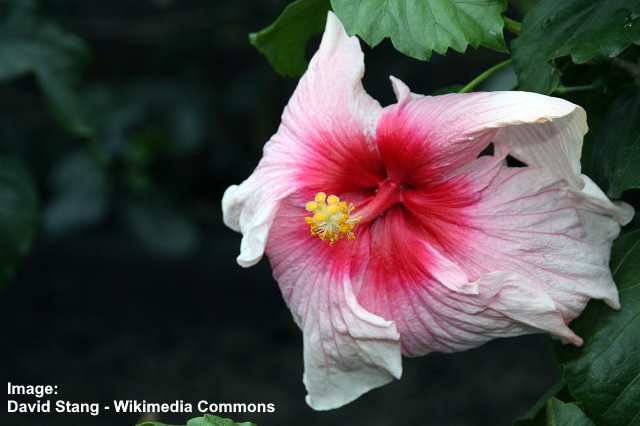
The tropical Hawaiian hibiscus ‘Waimea Pink’ has white flowers in the shape of a star. The elongated rounded petals are brilliant white when they bloom in the morning and gradually turn pink in the evening. This rose mallow species is Hibiscus waimeae and is native to Hawaii, where it’s called koki’o kea. This small hibiscus tree grows between 20 and 33 ft. (6 – 10 m).
Hibiscus rosa-sinensis ‘Rainbow Sherbet’
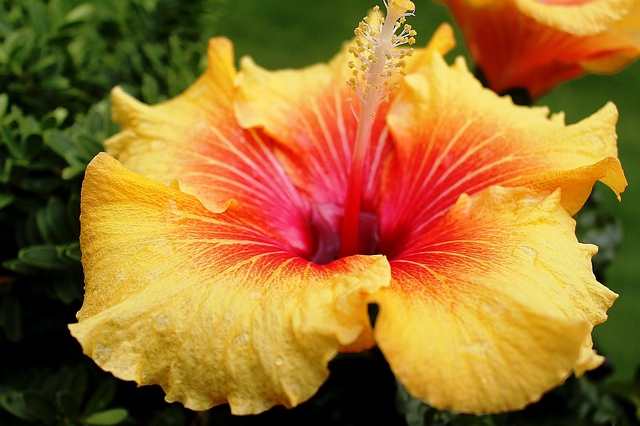
Hibiscus ‘Rainbow Sherbet’ is a stunning example of a tropical hibiscus thanks to its huge yellow funnel-like flowers with red centers. The spectacular flowers measure between 7” and 9” (17 – 22 cm). The Hibiscus rosa-sinensis ‘Rainbow Sherbet’ grows between 4 and 6 ft. (1.2 – 1.8 m) tall.
Related articles:
- How to Care for Hardy Hibiscus Shrubs
- Hibiscus Tree: Care and Growing Guide
- Rose of Sharon (Hibiscus Syriacus): Care & Varieties
